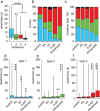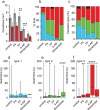Continuous behavioural 'switching' in human spermatozoa and its regulation by Ca2+-mobilising stimuli
- PMID: 31194869
- PMCID: PMC6736438
- DOI: 10.1093/molehr/gaz034
Continuous behavioural 'switching' in human spermatozoa and its regulation by Ca2+-mobilising stimuli
Abstract
Human sperm show a variety of different behaviours (types of motility) that have different functional roles. Previous reports suggest that sperm may reversibly switch between these behaviours. We have recorded and analysed the behaviour of individual human sperm (180 cells in total), each cell monitored continuously for 3-3.5 min either under control conditions or in the presence of Ca2+-mobilising stimuli. Switching between different behaviours was assessed visually (1 s bins using four behaviour categories), and was verified by fractal dimension analysis of sperm head tracks. In the absence of stimuli, ~90% of cells showed at least one behavioural transition (mean rate under control conditions = 6.4 ± 0.8 transitions.min-1). Type 1 behaviour (progressive, activated-like motility) was most common, but the majority of cells (>70%) displayed at least three behaviour types. Treatment of sperm with Ca2+-mobilising agonists had negligible effects on the rate of switching but increased the time spent in type 2 and type 3 (hyperactivation-like) behaviours (P < 2*10-8; chi-square). Treatment with 4-aminopyridine under alkaline conditions (pHo = 8.5), a highly-potent Ca2+-mobilising stimulus, was the most effective in increasing the proportion of type 3 behaviour, biasing switching away from type 1 (P < 0.005) and dramatically extending the duration of type 3 events (P < 10-16). Other stimuli, including 300 nM progesterone and 1% human follicular fluid, had qualitatively similar effects but were less potent. We conclude that human sperm observed in vitro constitutively display a range of behaviours and regulation of motility by [Ca2+]i, at the level of the single cell, is achieved not by causing cells to adopt a 'new' behaviour but by changing the relative contributions of those behaviours.
Keywords: behaviour; calcium; motility; pH; spermatozoa.
© The Author(s) 2019. Published by Oxford University Press on behalf of the European Society of Human Reproduction and Embryology.
Figures



Similar articles
-
Effects of pH manipulation, CatSper stimulation and Ca2+-store mobilization on [Ca2+]i and behaviour of human sperm.Hum Reprod. 2018 Oct 1;33(10):1802-1811. doi: 10.1093/humrep/dey280. Hum Reprod. 2018. PMID: 30239776
-
Ca2+ signals generated by CatSper and Ca2+ stores regulate different behaviors in human sperm.J Biol Chem. 2013 Mar 1;288(9):6248-58. doi: 10.1074/jbc.M112.439356. Epub 2013 Jan 23. J Biol Chem. 2013. PMID: 23344959 Free PMC article. Clinical Trial.
-
The clinical significance of calcium-signalling pathways mediating human sperm hyperactivation.Hum Reprod. 2013 Apr;28(4):866-76. doi: 10.1093/humrep/des467. Epub 2013 Feb 12. Hum Reprod. 2013. PMID: 23406974 Free PMC article.
-
Ca2+ signalling in the control of motility and guidance in mammalian sperm.Front Biosci. 2008 May 1;13:5623-37. doi: 10.2741/3105. Front Biosci. 2008. PMID: 18508611 Review.
-
[Roles of calcium ion channels and its clinical significance in sperm motility].Zhonghua Nan Ke Xue. 2008 Sep;14(9):832-6. Zhonghua Nan Ke Xue. 2008. PMID: 18998471 Review. Chinese.
Cited by
-
Behavioural switching during oscillations of intracellular Ca2+ concentration in free-swimming human sperm.Reprod Fertil. 2021 Mar 9;2(1):L5-L7. doi: 10.1530/RAF-21-0001. eCollection 2021 Jan. Reprod Fertil. 2021. PMID: 35128438 Free PMC article.
-
Prediction of Sperm Progression in Three Dimensions Using Rapid Optical Imaging and Dynamic Mechanical Modeling.Cells. 2022 Apr 13;11(8):1319. doi: 10.3390/cells11081319. Cells. 2022. PMID: 35455999 Free PMC article.
-
Tachykinins and Kisspeptins in the Regulation of Human Male Fertility.J Clin Med. 2019 Dec 31;9(1):113. doi: 10.3390/jcm9010113. J Clin Med. 2019. PMID: 31906206 Free PMC article. Review.
-
Modelling Motility: The Mathematics of Spermatozoa.Front Cell Dev Biol. 2021 Jul 20;9:710825. doi: 10.3389/fcell.2021.710825. eCollection 2021. Front Cell Dev Biol. 2021. PMID: 34354994 Free PMC article. Review.
-
Differences and Similarities: The Richness of Comparative Sperm Physiology.Physiology (Bethesda). 2020 May 1;35(3):196-208. doi: 10.1152/physiol.00033.2019. Physiology (Bethesda). 2020. PMID: 32293232 Free PMC article. Review.
References
-
- Aitken RJ, McLaughlin EA. Molecular mechanisms of sperm capacitation: progesterone-induced secondary calcium oscillations reflect the attainment of a capacitated state. Soc Reprod Fertil Suppl 2007;63:273–293. - PubMed
-
- Alasmari W, Barratt C, Publicover S, Whalley K, Foster E, Kay V, Martins da Silva S, Oxenham S. The incidence and clinical significance of defects in calcium signalling pathways mediating human sperm hyperactivation in donors and sub fertile patients. Hum Reprod 2013a;28:866–876, 4, DOI: 10.1093/humrep/des467. - DOI - PMC - PubMed
-
- Alasmari W, Costello S, Correia J, Oxenham SK, Morris J, Fernandes L, Ramalho-Santos J, Kirkman-Brown J, Michelangeli F, Publicover S, et al. . Ca2+ signals generated by CatSper and Ca2+ regulate different behaviours in human sperm. J Biol Chem 2013b;288:6248–6258, 9, DOI: 10.1074/jbc.M112.439356. - DOI - PMC - PubMed
-
- Bhaskar A, Subbanna PK, Arasan S, Rajapathy J, Rao JP, Subramani S. 4-aminopyridine-induced contracture in frog ventricle is due to calcium released from intracellular stores. Indian J Physiol Pharmacol 2008;52:366–374. - PubMed
Publication types
MeSH terms
Substances
Grants and funding
LinkOut - more resources
Full Text Sources
Miscellaneous

